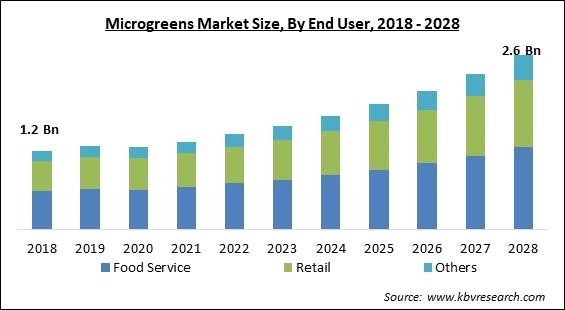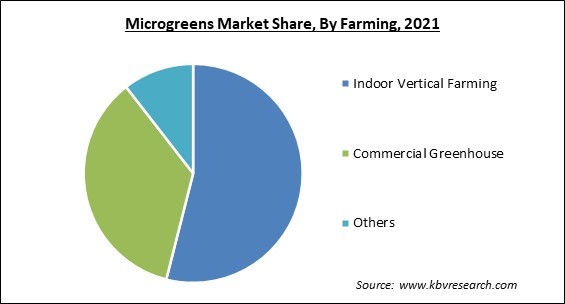The Global Microgreens Market size is expected to reach $2.6 billion by 2028, rising at a market growth of 10.6% CAGR during the forecast period.
Microgreens are small, soft vegetable greens that grow to be around one to three inches tall. When they have two completely grown cotyledon leaves, plants are plucked 7-14 days following germination, which is often referred to as "vegetable confetti." Due to its rich aromatic flavour and range of colours and textures, microgreens are mostly used to improve the colour, texture, or flavour of various cuisines like pasta, pizza, omelettes, and salads. A variety of minerals, vitamins, and antioxidants can be found in them.
Increased expenditure on premium food goods, healthy functional and nutritional foods, and rising adoption of indoor vertical and greenhouse farming are among the factors propelling the microgreens market forward throughout the forecast period. Microgreens are mostly grown in indoor vertical and greenhouse farms since they demand a lot of attention and a regulated environment. Furthermore, as microgreens-based oils and components are heavily sought for the manufacture of consumer items like shampoo and skincare products, expansion in the cosmetics and personal care industry is anticipated to boost of the product market during the forecast period. The Microgreens Market is predicted to benefit from increased adoption of farm mechanization and increased knowledge of high-tech farming methods such as hydroponics, aeroponics, and aquaponics.
Broccoli microgreens are the types of high-mineral source that may be grown by individuals, even in metropolitan areas, allowing for better nutrition availability. As a result of the increased nutritional demand from the rising population, broccoli output as a microgreen has expanded. People are becoming more interested in cultivating and eating microgreens as a result of rising culinary demand and the simplicity with which they may be cultivated, even by unskilled gardeners.

The COVID-19 epidemic has had a negative impact on the Microgreens Market Demand. Due to a disrupted supply chain and the closure of restaurants and grocery shops, which are important distributing points and end users of microgreens, sales of microgreens have decreased significantly. Along with that, the shutdown of shops and ban on imports and exports have further hampered the supply of microgreens. There are many people, who are looking forward to eat meals with high nutritional value and hence, they are adding microgreens in their meal for healthy body.
People's increased health concern has prompted them to consume a nutrient-dense diet, resulting in the development of indoor farming technologies. Indoor farming is not only practiced by consumers at home, but it is also widely practiced in huge greenhouses. As per a survey conducted by Artemis, an intelligence platform, a significant quantity of indoor cultivators produces microgreens. Along with that, people are increasingly adopting indoor faming for organic cultivation, which would create opportunities for market players.
Microgreens are an excellent approach to reduce the carbon footprint and reduce the reliance on non-local food sources if consumers want to achieve these aims. They're simple to cultivate at home, and they don't take up much space on the kitchen counter or window sill, no matter how small the living space is. People enjoy all the benefits of freshly picked organic food without having to travel to acquire it, alleviating the strain on the world's food supply. With so much uncertainty in the world today, people are looking for ways to de-stress, live more mindfully, and focus on what matters most.
One of the major negative consequence of microgreens to be mindful of, is the possibility of contamination due to the growth environment. Microgreens are a terrific way to eat healthy and save money because they can be grown in the house and garden. If user can decide to cultivate own microgreens, keep in mind that the risk of getting sick is greater than with other vegetables because microgreens are grown in an unsterilized method. It is important to trim them above the soil line, not below it, to avoid this. Also, it is important to make sure, they are properly washed because soil particles may remain on the plants, which can make people sick.

Based on End User, the market is segmented into Food Service, Retail, and Others. Retail segment procured a substantial revenue share in the microgreens market in 2021. It is due to the high prevalence of retail stores across various nations. Since consumers are increasingly adding on these microgreens, they are relying on retail sector to buy it for their consumption. This would further accelerate the demand and growth of the segment during the forecast period.
Based on Farming, the market is segmented into Indoor Vertical Farming, Commercial Greenhouse, and Others. Indoor Vertical Farming segment recorded the maximum revenue share in the microgreens market in 2021. Indoor vertical farming is the cultivation of agricultural produce in a controlled environment, such as a building, where crops are given the necessary conditions, like temperature, light, water, and growth media. This farming approach is gaining popularity in the worldwide product market since it allows growers to produce at any time of year and increases land productivity. As per the United Nations, the global population is anticipated to reach 9.8 billion by 2050, and current farming methods would be unable to meet the demand. Agriculture production is currently declining on a daily basis due to declining fertility of agricultural land and resource depletion.
Based on Type, the market is segmented into Broccoli, Arugula, Cabbage, Cauliflower, Peas, Basil, Radish, Cress, and Others. Arugula segment procured a significant revenue share in the microgreens market in 2021. The soft, bite-sized leaves of arugula, also referred as rocket or roquette, have a tart flavour. Arugula, like other leafy greens, has a high concentration of helpful nitrates and polyphenols. Arugula is abundant in calcium and vitamin K, two important elements for bone health. Owing to these nutritional values, the growth of the segment would surge in the coming years.
| Report Attribute | Details |
|---|---|
| Market size value in 2021 | USD 1.3 Billion |
| Market size forecast in 2028 | USD 2.6 Billion |
| Base Year | 2021 |
| Historical Period | 2018 to 2020 |
| Forecast Period | 2022 to 2028 |
| Revenue Growth Rate | CAGR of 10.6% from 2022 to 2028 |
| Number of Pages | 214 |
| Number of Tables | 408 |
| Report coverage | Market Trends, Revenue Estimation and Forecast, Segmentation Analysis, Regional and Country Breakdown, Companies Strategic Developments, Company Profiling |
| Segments covered | End User, Farming, Type, Region |
| Country scope | US, Canada, Mexico, Germany, UK, France, Russia, Spain, Italy, China, Japan, India, South Korea, Singapore, Malaysia, Brazil, Argentina, UAE, Saudi Arabia, South Africa, Nigeria |
| Growth Drivers |
|
| Restraints |
|
Based on Regions, the market is segmented into North America, Europe, Asia Pacific, and Latin America, Middle East & Africa. North America emerged as the leading region in the microgreens market with the maximum revenue share in 2021. People are predicted to gravitate toward microgreens with the rise and evolution of wellness-focused diets, that include green vegetable salads and organic-based food items. The demand for microgreens is increasing rapidly in the United States, owing to the health benefits connected with their consumption, such as lower risk of heart disease, chronic diseases, cancer, and Alzheimer's disease. Consumers are increasingly choosing high-protein diets, necessitating a significant demand for high-protein, low-carb food products.
Free Valuable Insights: Global Microgreens Market size to reach USD 2.6 Billion by 2028
The market research report covers the analysis of key stake holders of the market. Key companies profiled in the report include AeroFarms, LLC, Gotham Greens Holdings, LLC, Fresh Origins, The Chef's Garden, Inc., Farmbox Greens, LLC, Living Earth Farm, Bowery Farming, Inc., and Teshuva Agricultural Projects Ltd.
By End User
By Farming
By Type
By Geography
The microgreens market size is projected to reach USD 2.6 billion by 2028.
Growing trend of indoor farming are increasing are driving the market in coming years, however, side effects of consuming microgreens growth of the market.
AeroFarms, LLC, Gotham Greens Holdings, LLC, Fresh Origins, The Chef's Garden, Inc., Farmbox Greens, LLC, Living Earth Farm, Bowery Farming, Inc., and Teshuva Agricultural Projects Ltd.
The Food Service segment acquired maximum revenue share in the Global Microgreens Market by End User in 2021, thereby, achieving a market value of $1.24 billion by 2028.
The Broccoli segment is leading the Global Microgreens Market by Type in 2021, and would continue to be a dominant market till 2028; thereby, achieving a market value of $617.1 million by 2028.
The North America market dominated the Global Microgreens Market by Region in 2021, and would continue to be a dominant market till 2028; thereby, achieving a market value of $952.3 million by 2028.
Our team of dedicated experts can provide you with attractive expansion opportunities for your business.

